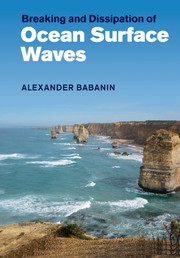Book contents
- Frontmatter
- Contents
- Preface
- 1 Introduction
- 2 Definitions for wave breaking
- 3 Detection and measurement of wave breaking
- 4 Fully nonlinear analytical theories for surface waves and numerical simulations of wave breaking
- 5 Wave-breaking probability
- 6 Wave-breaking severity
- 7 Energy dissipation across the wave spectrum
- 8 Non-dissipative effects of breaking on the wave field
- 9 Role of wave breaking in the air–sea interaction
- 10 Conclusions. What else do we need to know about wave breaking?
- References
- Index
5 - Wave-breaking probability
Published online by Cambridge University Press: 25 October 2011
- Frontmatter
- Contents
- Preface
- 1 Introduction
- 2 Definitions for wave breaking
- 3 Detection and measurement of wave breaking
- 4 Fully nonlinear analytical theories for surface waves and numerical simulations of wave breaking
- 5 Wave-breaking probability
- 6 Wave-breaking severity
- 7 Energy dissipation across the wave spectrum
- 8 Non-dissipative effects of breaking on the wave field
- 9 Role of wave breaking in the air–sea interaction
- 10 Conclusions. What else do we need to know about wave breaking?
- References
- Index
Summary
As already mentioned in Chapter 2 dedicated to definitions of wave properties and phenomena related to wave breaking, the breaking probability, or as it is also often called breaking rate or frequency of breaking occurrence is one of the most important statistical characteristics of wave fields that contain the breaking events. Technical definitions for the breaking probability are given in Section 2.5.
Together with the breaking severity (Section 2.7, Chapter 6), the probability defines the wave-energy dissipation due to wave breaking. Knowledge of such dissipation is required across a broad range of wave-related applications, with the wave forecast being the most frequent and obvious, and therefore the breaking occurrence has enjoyed key attention within wave-breaking studies.
Experimental and statistical techniques of breaking-probability studies have been discussed in detail in Chapter 3, and theoretical approaches in Chapter 4. As described in these chapters, in the past parameterisations of the breaking rates in terms of environmental characteristics have usually relied on wind speed or its derivatives. In this book, we have argued that, although the wind is of course essentially responsible for the formation of fields of wind-generated waves, its capacity to directly trigger or even affect a breaking event is only marginal, except perhaps for very strong wind forcing. Breaking mainly happens due to hydrodynamic phenomena, that is due to processes in the wave train itself.
- Type
- Chapter
- Information
- Breaking and Dissipation of Ocean Surface Waves , pp. 142 - 218Publisher: Cambridge University PressPrint publication year: 2011

